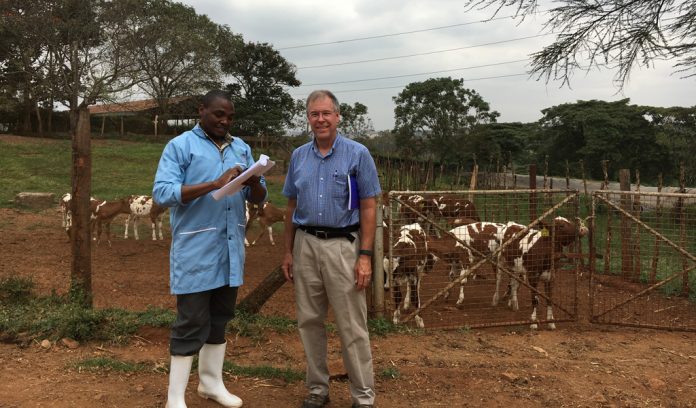
SALEM, Ohio — When Dwight Roseler travels back to Kenya this year, he hopes to help dairies with hundreds of cows, large staffs and automation — but also small farmers, like Mr. Mugo.
Mugo has a handful of milking cows and generates enough income to live on a small subsistence farm near Nakuru, a city of roughly 2 million, located northwest of the capital city of Nairobi. Mugo purchases fodder and buys grain. Every day, he milks by hand and hauls the milk into town to a creamery.
Over the next few years, it will be Roseler’s job to create dairy feed rations in Kenya for Land O’Lakes, Inc., — ideally, a role that will benefit not only large dairies, but small farmers like Mugo, Roseler said.
It has the potential to improve production in a country that has more cows than the U.S., according to Roseler, in an area only slightly smaller than Texas.
Estimates compiled by various organizations, including the United Nations’ Food and Agricultural Organization, are broad, but the consensus is that there are more cattle there than in the U.S.
According to a U.N. report on Kenya, “grade cattle breeds account for less than 30 percent of the total cattle population, but contribute about 70 percent of estimated annual milk production and almost all the formally marketed milk.”
To Africa
Kenya dairy at a glance
Location: Eastern Africa, bordered by the Indian Ocean, Tanzania, Uganda, South Sudan and Somalia.
Size: 224,000 square miles (slightly smaller than Texas)
Population: 49.7 million people (double the population of Texas)
Milk production: 898 million gallons
Milk price: $14-20 per cwt. (equivalent to)
Number of dairy cattle: 9+ million; estimated to be more than U.S. (includes exotic breeds)
Breeds of dairy cattle: Friesian, Ayrshire, Guernsey and Jersey. Exotic breeds are part of some estimated dairy cattle numbers, and include East African Zebu and Sahiwal.
Global position: Sub-Saharan dairy production is 18% of global industry; Kenya accounts for 3% of that production.
Sources: Dwight Roseler; Kenya Ministry of Livestock Development; Food and Agriculture Organization of the United Nations; Kenya’s National Farmers Information Service.
Roseler, based in Wooster, Ohio, is the dairy technical manager for part of the Great Lakes region of the Purina Animal Nutrition arm of Land O’Lakes. He works with 200,000 cows across the Midwest. Starting in August 2018, he began a three-year commitment that will take him to Kenya a couple of times a year.
Several years ago, Land O’Lakes partnered with Bidco, a Kenyan grain processor. Roseler’s task will be to formulate dairy feed rations from the byproducts of Bidco’s grain processing at its mill in Nakuru. He will also do forage testing, and run training sessions on how to improve cow health. (Teaching is not new for him. He is also an adjunct professor for The Ohio State University.)
“The farms are very much interested in learning how to improve,” Roseler said.
Chance to improve
According to Land O’Lakes, the demand for meat and dairy products is increasing in Kenya, but only about 5 percent of farms are commercialized enough to meet even a portion of the demand.
The production model in Kenya is different, Roseler said. It relies on less machinery and automation; conversely, hourly wages are cheap. One 200-cow dairy he visited had dozens of employees. In visits to 25 dairies, Roseler said he saw a wide variety of management styles, sizes and levels of automation.
While farmers might harvest silage, Roseler said it’s often made of elephant grass, a high dry-matter yielding grass that grows well in tropical climates and is drought resistant, but produces only a moderate quality forage, according to a 2016 article in Livestock Research for Rural Development. Even at large dairies, heifers don’t start milking until about 3 years old, Roseler said.
“The infrastructure there is not anything like what we have in the U.S.,” Roseler said, adding, “It’s very much in the infancy, in terms of the industry.“
“It reminds me of back when I first started in the early ’80s,” Roseler said. “There were a lot of small farms then. There has been a lot of consolidation (in the U.S.).”
He added that Land O’Lakes sees an opportunity to help improve calf nutrition and, in turn, help growth rates.
There is also opportunity on the processing side of the dairy business, Roseler said. Small farmers will load their milk into large, metal jars and haul it to their town or village creamery for payment. It is not uncommon to see bicycles whiz down roads, jars strapped to the back.
Kenya by the numbers
Sub-Saharan Africa accounts for 18 percent of global milk production. Kenya makes up 3 percent of that amount, with roughly the equivalent of 898 million gallons of milk produced, according to a 2017 report from the Kenya Ministry of Livestock Development.
“The milk price (in Kenya), surprisingly, wasn’t that different than ours per hundredweight,” Roseler said.
August was the first time Roseler traveled to Kenya, but he enjoyed it.
He first tasted “chai na maziwa” (tea with milk, which is a Kenyan staple) at Mr. Mugo’s .
“It’s wonderful,” he said.
Details
To learn more about the project, contact Dwight Roseler at dkroseler@gmail.com.











Best of luck to Mr. Roseler/Purina Corp.
Latest in Kenya is the big, fat, “easy terms” loan that Kenya accepted from China. The Kenyan lawyers didn’t read the fine print in the loan papers. If China was not paid, Kenya pledged its sovereign assets, like infrastructure, to secure payment. Kenya defaulted and now–TA DA!–China owns/took over its main port, Mombassa! Who needs wars when paperwork does the same thing:
Milk production in Kenya is now estimated at 5.6bn litres per year(including camels and goats).
Cattle milk value chain stands at 4.1billion litres per year with 650 million litres processed per year. ~ Harry Kimtai, PS @kilimoKE
#MaziwaSafi